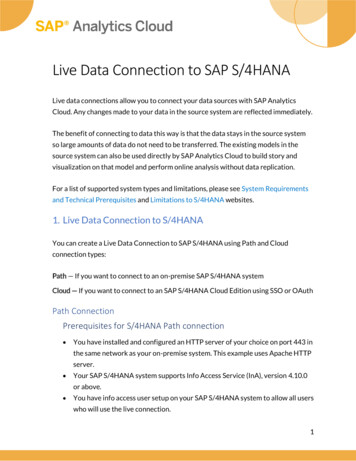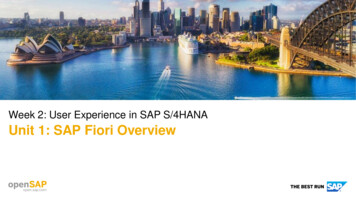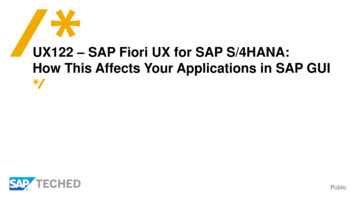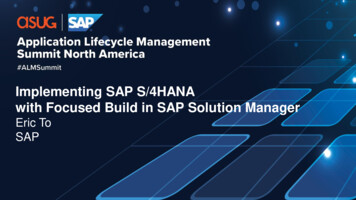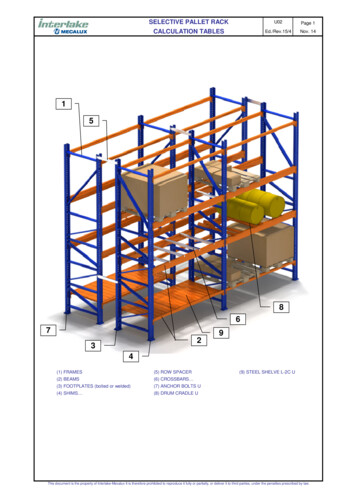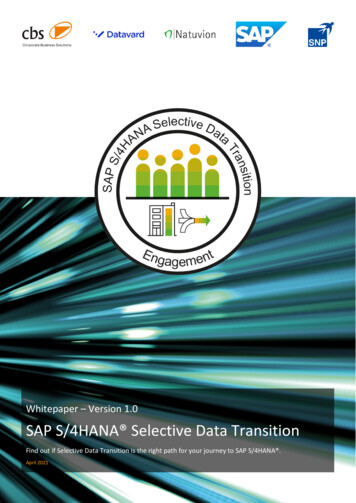
Transcription
Whitepaper – Version 1.0SAP S/4HANA Selective Data TransitionFind out if Selective Data Transition is the right path for your journey to SAP S/4HANA .April 20211SAP S/4HANA Selective Data Transition
Table of ContentsManagement Summary4Selective Data Transition Compared to New Implementation and System Conversionof SAP S/4HANA 5The SAP S/4HANA Selective Data Transition Engagement9What is the purpose of the engagement?SAP S/4HANA Selective Data Transition Engagement MembersWhat does it mean to be a member of the engagement?Selective Data Transition in d SAP S/4HANA installation typesScope delimitationDriver for a Selective Data TransitionWhy historical data?Motivation to transfer historical dataCurrent system landscapeBig-bang vs. step-by-stepSimilarity of source and targetComplexity of data selectionDegree of data changesData volume and performance requirementsCombine a transition to SAP S/4HANA with new functionalitiesSpecific Selective Data Transition requirements in projectsDecision criteriaDiscoverPrepareExploreRealizeDeploy / RunQuality Gate / MilestoneTechnical ApproachTable-based transition approach2SAP S/4HANA Selective Data 181919202020212222
Creation of target systemNew InstallationRe-use of existing installationProductive SAP S/4HANA installationSystem landscape, requirements, and performanceReal Customer Use CasesSpeed up your journey to SAP S/4HANA Move to SAP S/4HANA step-by-stepTakeover of selected processes / data only to SAP S/4HANA Transition of multiple ERP’s into one SAP S/4HANA Data transition into a running SAP S/4HANA 2222232324252526262627Success Criteria for a Selective Data Transition28Next Steps & Contacts29Members in alphabetical order3SAP S/4HANA Selective Data Transition29
Management SummaryThe SAP S/4HANA Selective Data Transition Whitepaper is a “must-read” document forcustomers considering their transition to SAP S/4HANA .Next to the two SAP standard options for the transition to SAP S/4HANA – New Implementation (aka greenfield approach) and System Conversion (aka brownfield approach)– a Selective Data Transition can be interesting for you as it combines several aspects ofthe options above and provides additional aspects that can add safety and flexibility toyour individual transition path. A Selective Data Transition to SAP S/4HANA goes beyond a standard New Implementation or System Conversion and is always performedwithin a customer-specific project. The aim of this paper is to explain the specific elements of a Selective Data Transition and provide you with key decision criteria that helpyou to decide if a Selective Data Transition is a possible path for you and your journeyto SAP S/4HANA .The document includes a brief comparison of the transition options, but it sets a clearfocus on the Selective Data Transition. To evaluate if a New Implementation or SystemConversion addresses your needs, refer to the practical SAP guide as a starting point.A Selective Data Transition to SAP S/4HANA ,combines a flexible redesign of business processes while retaining historical data alignedto a new business reality. In fact, it allows youto freely select the transferred set of data andleave non-selected data behind. For example,data belonging to obsolete organizationalunits.An additional benefit is the possibility to flexibly re-organize the target system landscapeand merge or split systems according to yourrequirements. This is often the case as organizations set up regional systems and/or splitthe landscape into different divisions.In addition, the Selective Data Transition approach is ideally suited for customers lookingfor a phased Go-Live approach (for examplecounty by country) and/or a minimized4SAP S/4HANA Selective Data Transitiondowntime approach as the migration canhappen in waves of organizational units.To provide these benefits, the Selective DataTransition requires experience and a set ofproven methods, tools and software. SAP hasformed a global expert community (SAPS/4HANA Selective Data Transition Engagement) to standardize this approach and guarantee a consistent quality of execution. Themembers of this community will engage withyou and/or your partner of choice to provideyou with a reliable and proven transition toSAP S/4HANA .This whitepaper provides IT decision-makers,IT architects and project managers of the SAPS/4HANA Transition with a comprehensiveoverview about the pros and cons as well asthe architectural assumptions behind the Selective Data Transition approach.
Selective Data Transition Compared to New Implementation and System Conversion of SAP S/4HANA The way you plan and execute your SAP S/4HANA program will substantially influenceyour ability to adopt next-generation business processes and use the new capabilitiesof SAP products. Needless to say, making the right choices in this planning step is ofgreat importance to the rest of your transition journey.Figure 1: Transition Options to SAP S/4HANA With a New Implementation, you build afresh SAP S/4HANA system and either cutover to the new system (the so-called “bigbang” scenario) or migrate the individualbusiness units sequentially from your legacySAP ERP application to the new system (“aphased rollout”).The SAP S/4HANA Migration Cockpit is SAP’srecommended tool of choice to transfer business data to the SAP S/4HANA target system. It loads data by using SAP standard APIsand offers preconfigured data migration objects for master data, open items, and balances. You can also transfer selected additional data using a Selective Data Transitionapproach.With a System Conversion, you turn your existing SAP ERP system into an SAP S/4HANA system. Technically, the System Conversion is5SAP S/4HANA Selective Data Transitiona one-step procedure with a single downtimethat is comprised of the following: For SAP ERP on any database: a databasemigration to SAP HANA 2.0 (a new database system)A software upgrade, that is, replacing SAPERP application code with SAP S/4HANA application codeA conversion of the data from the SAP ERPdata model to the SAP S/4HANA datamodelFor SAP ERP powered by SAP HANA, transition to SAP S/4HANA is an in-place conversion. It also requires an upgrade fromSAP HANA 1.0 to SAP HANA 2.0 as an extra step within the conversion project.
A Selective Data Transition goes beyond astandard New Implementation or SystemConversion and allows you to freely select thetransferred set of data. This transitionmethod also provides no restrictions to theSAP S/4HANA target system’s planned operation.For a System Conversion, the full set of dataremains in the system. Within a SelectiveData Transition, you get the option totransfer less data and leave selected databehind. For example, data belonging toobsolete company codes could be left behind.For a System Conversion, the business processes configured in the system remain asthey are, except for any necessary adjustments resulting from data model changesor simplifications. Within a Selective DataTransition, you get the option to selectprocess- or module-wise data in whichyou want to continue with.Usually, the additional data is transferredwith a table-based approach requiringspecial expertise. This normally includestransferring a certain amount of historicaldata. For example, you could transfer financial documents of the last 2 years, oryou could transfer data belonging to longrunning projects. It is possible to leavedata behind that is no longer needed.In the end, there is no right or wrong way. Eachcustomer needs to choose the option that allowshim to continuously adopt SAP innovations in thefuture. For an overall view, Fig. 2 shows a comparison of the three different approaches.6SAP S/4HANA Selective Data Transition
System ConversionSelective DataTransitionNewImplementationSAP StandardIndividual expert projectSAP Standard Split/Merge of systems Data transformation (mapping, harmonization) Data cleansing CriteriaType of projectProcess re-engineeringPhased rollout – orgUnit perorgUnit Not included but possiblein subsequent next steps(full system converts at once)Data ScopeFull data set Initialize target system withmaster data, open itemsand balances Selected transactionalhistory Source: Target System ratio1:1 n:m (e.g. n:1, 1:n, 6:1) SAP S/4HANA Installation TypeOn premise On premise,deployed in SAP HEC SAP S/4HANA Private Cloud ( ) 1 SAP S/4HANA Public Cloud Figure 2. Approach Comparison1 ) The Selective Data Transition suits for the SAP S/4HANA On-Premise. In principle, the Selective Data Transition also supports a migrationto the Private Cloud. The solution must follow the SAP Cloud roadmap and strategy and can therefore only be implemented in coordinationwith SAP. It must be ensured that the migration is carried out with and according to the standards, methods, content and, if necessary, alsoon a technology.7SAP S/4HANA Selective Data Transition
This paper will detail specific elements of a Selective Data Transition and help you to decide if aSelective Data Transition can address your requirements. Refer to the following chapters for detailsand decision criteria. For further information about New Implementation and System Conversion,refer to the practical guide SAP has provided.8SAP S/4HANA Selective Data Transition
The SAP S/4HANA Selective Data TransitionEngagementIn 2018, an increased demand for more flexible options to master the transition to SAPS/4HANA was recognized in the market.SAP responded to this demand by founding a group of partners that have a successfultrack record in system landscape transformation projects over the past years.Figure 3. Founding Member Companies of the SAP S/4HANA Selective Data Transition EngagementThe main goal of the engagement is to use thecombined knowledge and experience of allmembers out of several thousand successfulSAP ERP migration projects to ease up theway to SAP S/4HANA .With their market experience, these expertcompanies established the table-based migration approach as a well-known and securestandard in the SAP ecosystem.Combining the knowledge of the foundingmembers will result in meeting the demandfor more flexibility and assuring that the Selective Data Transition projects will be delivered with the same high-quality standardsacross the market.9SAP S/4HANA Selective Data TransitionThis engagement was designed to help customers quickly move to SAP S/4HANA whilealso speeding up the realization that this newtransition method, the Selective Data Transition, exists to provide industry-wide standards.
What is the purpose of the engagement?As the global expert community for SAP System Landscape Optimization (SLO) the SAPS/4HANA Selective Data Transition Engagement establishes joint standards, methodsand processes to provide customers with a reliable and proven transition approach to SAPS/4HANA . The approach combines flexibleredesign of business processes with retainingselected historical data aligned to a new business reality.Within this engagement, SAP and partnersagree on common principles for the procedure and quality standards in Selective DataTransition projects. SAP and Partner contribute in different functional and technical corecompetencies.The engagement members create real customer value in the following areas: Quality standards for solutioning and project managementDelivery of complex Selective Data Transitions to SAP S/4HANA Aligned valid transition scenariosBest practices and solution patterns forresolution of transition scenariosA common approach for a tool-basedtransitionSAP S/4HANA Selective Data Transition Engagement MembersThe variety of requirements that can be covered with a Selective Data Transition projectsis huge.Typically, these projects are customer-specific and need a detailed assessment of whatis involved in such a project.10SAP S/4HANA Selective Data TransitionSAP strongly advises customers to engage SAPDigital Business Services or specialized SAPPartners equipped with the necessary toolsand experience with such an approach.Partners who are members of the SAPS/4HANA Selective Data Transition Engagement have advanced expertise and experience with Selective Data Transition projects indifferent functional and technical areas. Thepartners also know about the opportunities,risks, and complexities of a Selective DataTransition.Members of the engagement collaboratewith SAP in defining reasonable and feasibleproject, quality, and technical standards.What does it mean to be a memberof the engagement?Being a member means to actively participatein the work areas defined by the engagementgroup. Each member needs to proactivelycontribute to the defined workstreams andcomplies with the engagement guidelines andstandards defined.SAP acts as moderator and is a member.Being a member of the engagement does notrepresent an endorsement, approval or certification by SAP for the technical, functionaland business logic of each partner solution.
Selective Data Transition in DetailA Selective Data Transition represents an attractive mixture of the New Implementationand System Conversion approach. This means it combines advantages from both approaches in one and offers customers a high level of flexibility in the context of datatransfer and process harmonization to the future SAP S/4HANA system.CharacteristicsBenefitsThe main characteristics of a Selective DataTransition can be summarized as follows:In comparison to the standard approaches tomove to SAP S/4HANA , the Selective DataTransition approach provides the followingbenefits according to the area of usage: 11The transfer of entire or selective historical data into SAP S/4HANA is possiblewithout limitations based on a tablebased migration procedureThe data transfer on database level allowsa high-speed migration of high volumes ofdata with maximum flexibilityA selective data tr
The Selective Data Transition suits for the SAP S/4HANA On-Premise. In principle, the Selective Data Transition also supports a migration to the Private Cloud. The solution must follow the SAP Cloud roadmap and strategy and can therefore only be implemented in coordination with SAP. It must be ensured that the migration is carried out with and according to the standards, methods, content and, if

